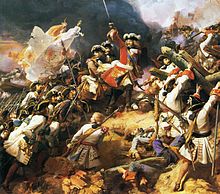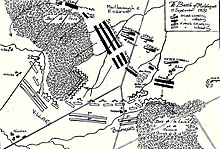Battle of Malplaquet
| date | September 11, 1709 |
|---|---|
| place | south of Mons , Belgium |
| output | Allied Pyrrhic victory |
| Parties to the conflict | |
|---|---|
| Commander | |
| Troop strength | |
| 80,000 men 90 guns |
90,000 men and 120 guns |
| losses | |
|
11,000 dead and wounded |
25,000 dead and wounded |
Carpi - Chiari - Cremona - Kaiserswerth - Luzzara - Cádiz - Friedlingen - Vigo - Schmidmühlen - Ekeren - Höchstädt (1703) - Gibraltar - Speyerbach - Schellenberg - Bonn - Höchstädt (1704) - Vélez-Málaga - Cassano - Barcelona (1705) - Sendlinger Murder Christmas - Calcinato - Ramillies - Turin - Castiglione - Almansa - Toulon - Lille - Oudenaarde - Malplaquet - Almenara - Saragossa - Brihuega - Villaviciosa - Denain - Rio de Janeiro - Barcelona
In the battle of Malplaquet in northern France, south of the Belgian city of Mons , on September 11, 1709, an Allied army under Marlborough and Prince Eugene defeated a French contingent during the War of the Spanish Succession .
prehistory
In June 1709 the allies began the campaign in Flanders with the siege of Tournai . The Allied Army in this theater of the War of the Spanish Succession , commanded by Marlborough and Prince Eugene, was 90,000 strong and had 120 guns . The city fell in late July, followed by the citadel on September 3 .
The French army under the command of Claude-Louis-Hector de Villars was waiting for reinforcements from the Rhine and Spain . The French army was numerically inferior to the allies with 80,000 men and 90 guns. Nevertheless, de Villars dared an open field battle so as not to lose the city of Mons .
First the French tried to attack the allies during the march. This failed, however: Marlborough found out about it in time and stopped his army. The French then prepared for the battle and began building three consecutive entrenchments in the forests of Sars and Lanière , for example in the area of today's Belgian-French border near Quévy . Marlborough concentrated the fire of its artillery on the French, but from a very great distance for the time. The French were still able to continue their work.
Course of the battle

At 8 a.m. on September 11, the right wing advanced under Prince Eugene and tried to get into the flank of the French. His troops , composed of imperial , imperial , Danes and Saxons , most of which were under the command of General Johann Matthias von der Schulenburg , could not penetrate. The Dutch and Prussian infantry under Prince Johann Wilhelm Friso of Orange and the Baron François-Nicolas Fagel (1645–1718) on the left wing also encountered fierce resistance. Already an extremely lossy battle was emerging.
The front line attack by the Allied right wing was repulsed, with two of the three commanding major generals and all colonels either killed or wounded. The second and third line attacks also failed. Only after a massive bombardment by the Allied artillery could the fourth attack (with Irish soldiers from the British Army shooting at Irish mercenaries in French service) drive the French out of the forest. Prince Eugene fought in the front row and was wounded. But the left wing of the French still held, as did the right wing, where the attack by the Dutch and Prussian infantry collapsed with heavy losses.
However, the continued attacks by the Allies on the wings meant that gradually all French reserves were ordered to the wings. Most recently, parts of the troops stationed in the center were even used to reinforce the wings. Now all of the Allied reserves, consisting mainly of English, Scottish and Welsh troops, were thrown from Marlborough against the weakened French center. At about 2 p.m. these units broke into the position of the French. Under the massive fire of the Allied artillery, the British troops managed to take the opposing entrenchments, which were only sparsely occupied. Encouraged by this success, the Dutch, who had been repulsed twice with heavy losses, broke through the French right flank.
The entire Allied cavalry with 30,000 riders who had not yet been deployed followed closely on the infantry. The first Allied cavalry regiments had barely passed the entrenchments and formed when they were attacked by French cavalry. The latter fought so bravely that she succeeded in pushing the Allied riders back to the entrenchments of the center six times. There, however, the French cavalrymen expected concentrated infantry and artillery fire every time, forcing them to retreat. When all the Allied cavalry squadrons had passed the entrenchments, however, they were able to exploit their numerical superiority over the French, who had only 20,000 mounted men. After a wild equestrian battle in the heathland around Malplaquet, the French Marshal de Boufflers , who had taken over the command instead of De Villars, who was injured in the knee, gave the order to retreat at 3 p.m. Realizing that the battle was no longer to be won, he preferred an orderly retreat to a savage escape. Between 3 p.m. and 4 p.m., the French withdrew under cover of their cavalry in good order, leaving the battlefield and victory to the Allies.
The allies lost 25,000 dead, wounded and missing; the army was too weakened to pursue the enemy. The French lost 11,000 to 15,000 men (depending on the source), but they were still very high. The Battle of Malplaquet was the bloodiest in the War of the Spanish Succession.
Swiss troops on both sides
Swiss mercenary troops fought in both camps : on the French side, two battalions of the Swiss Guards and four other regiments ; six regiments on the side of the Dutch. There were also two Bernese regiments led by members of the von May patrician family: Gabriel von May was in the service of the Netherlands, Hans Rudolf von May served France.
This fratricidal struggle with more than 8,000 Swiss men lost in the service of opposing parties provoked violent reactions in the Confederation . In the Diet there was a dispute between supporters and opponents of the foreign services. Until the Battle of Bailén in 1808, Swiss mercenaries no longer fought against each other.
literature
- John A. Lynn: The Wars of Louis XIV 1667-1714 . Longman, London 1999, ISBN 0-582-05629-2 .
- Hans Delbrück: History of the art of war in the context of political history . Berlin 1920, part 4, pp. 370-372 .

